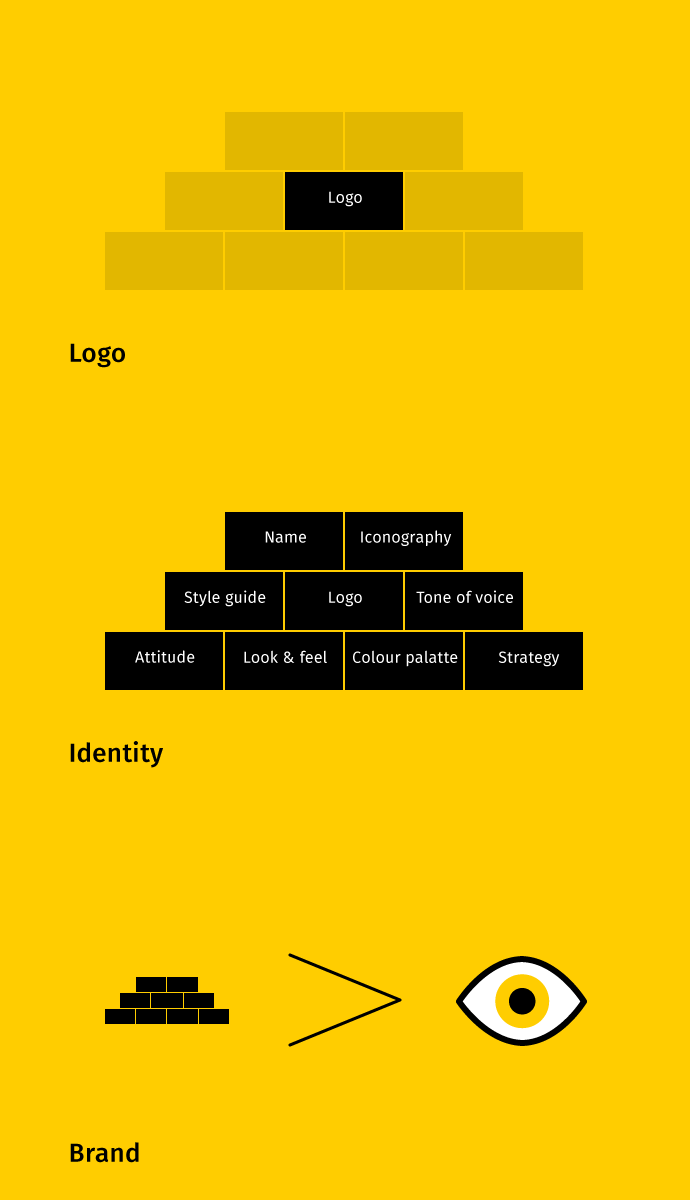There’s always been a bit of confusion when it comes to people outside the design profession talking about logos and identities and to be honest it’s probably our own fault. For some reason we tend to find it difficult to explain exactly what it is we do — well, actually I’m sugarcoating it, we’re pretty damn awful at it.
Over the past few weeks there’s been a couple of controversies over identities and their costs that’s brought this to light. What seems to have happened is that an agency was either approached or tenders for a job. They get it, complete it, bill it, get paid and then someone somewhere sees that the work cost (£/€/$) 100K or 50K or something. Then they start kicking up a stink that the logo cost so much and that a good logo can be got for a fiver. Except that that’s where the mix up happens. People think the client got a logo for 100K whereas they got an identity. These are two very different things.
1. A logo is a picture. It is a small, important but not overly important part of a identity.
2. An identity is how the company appears across their media and how they portray themselves. It can include: their strategy; their tone of voice; their name; their look and feel and of course their logo.
3. A brand is the public’s perception of a company’s advertising, marketing and identity.
“[A brand…] It’s the result of what the company does, not the cause of it.”
— Robert Jones, Wolff Olins
If we think of it in terms of a building, a logo is a block — one of many — used to create an identity. The identity in this sense is the physical building and the brand is your emotions and view of the building. An organisation’s identity can be extremely complex and takes time to get right. This is why they cost money. It’s also why they are worth the investment. If you get it right it can be an incredibly powerful asset for your business.

Take brands such as Coca-Cola, Apple or Nike, they have logos that haven’t changed much (if at all) over time but they have invested heavily in their identities and branding. When you think of Nike’s brand you don’t think of a swoosh, you think of a lifestyle – the same goes for Apple. So when someone gets all up in arms about the cost of a logo (when they mean an identity), I can understand where they are coming from but they might not know the whole story.
Two examples of this happening lately are the Irish Water and the Amsterdam city identities.
The Irish Water identity was designed by Zero-G, a Dublin-based company with a portfolio of identities for large and complex companies and organisations within Ireland and abroad including; Bord Gáis, The Science Gallery & The Abbey Theatre. Who better, you might ask, than them to tackle the job? Well actually, they were a great choice for the job and their fee (reported as being €20,000) seems very reasonable. Their fee was for the identity after all, not the logo.
“20K for a logo, sure that’s 5K per word!”
Everyone who was lambasting it picked up on one thing, the logo cost €20,000. Except it didn’t. That was the cost for an entire identity, the logo is merely one part of the identity, and one of the least complicated at that.
That’s where the USI and others who reported on it got it wrong. They reported that 20K for a logo was ridiculous and that the money could be better spent elsewhere. They even wrote an open letter and presented a logo they got through a crowd sourcing website for less than a fiver. A cost they deemed reasonable. They later apologised after two students from DIT wrote them this well-worded response.
Across in Amsterdam Edenspiekermann updated the city’s identity. They too received a lot of criticism over their costs. You can read a great blog post they wrote pointing out that it wasn’t just a logo here. It’s great to see them standing up for the work they have done and justifying the costs. These kinds of jobs are extremely complex and take months of work to complete, all of which adds to their cost. But when they are done right they can be a prudent and worthwhile investment.
So if you take anything from this it’s that a logo isn’t an identity.